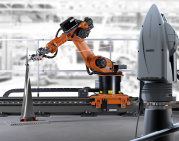Large Volume Metrology
The last decades have shown great improvements in the field of engineering dimensional metrology. The introduction of modern computational systems, ever more compact microelectronic devices and innovative materials have given a significant impulse to the accuracy and application of traditional devices. Recent developments have included applications both for extremely small-sized and for extremely large-sized objects. Following this, two new branches of dimensional metrology have demonstrated their maximal potentiality: ‘‘nano-metrology’’, related to the measurement of extremely small objects, and ‘‘Large Volume Metrology’’ (LVM), which refers to the measurement of large engineering structures.
To begin with nano-metrology, the current widespread success can be ascribed to the new generations of scanning electron microscopes (SEMs) and, even more, to atomic force microscopes (AFMs), which allow us to obtain precise and accurate measurements of very small elements and structures. On the other hand, large-scale dimensional metrology has reached its historic turning point with the introduction of modern very accurate and flexible optical systems.
LVM takes over when items are too big or difficult to move to a separate measuring device such as a Coordinate Measuring Machine. This often means that items must be measured in situ, at the point of manufacture or assembly. This brings a set of challenges not encountered in typical calibration laboratory environments - apart from the physical size (1 m up to hundreds of metres or km) thermal effects, refractive index and fixture stability can disturb measurements.



